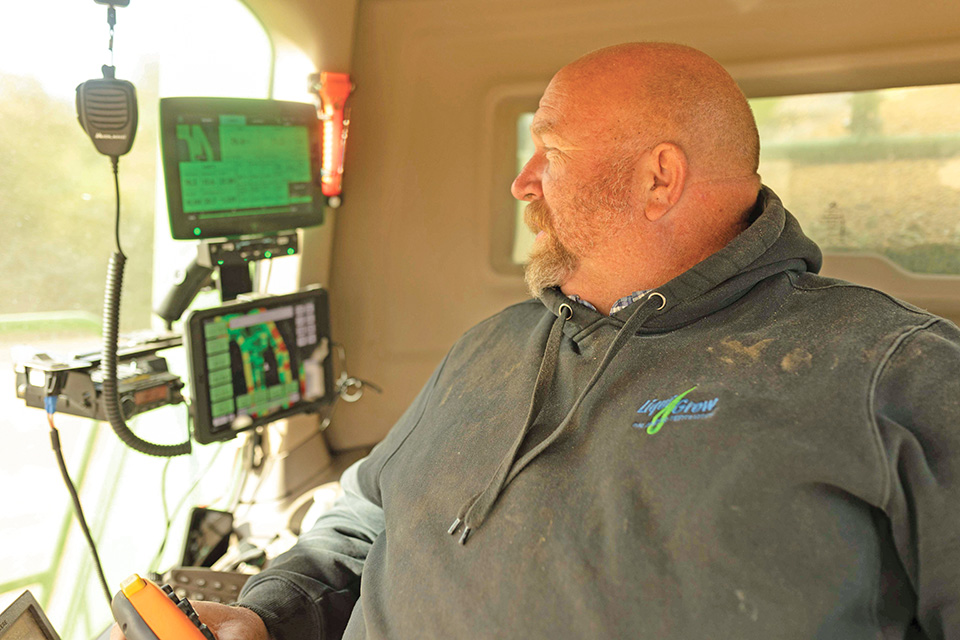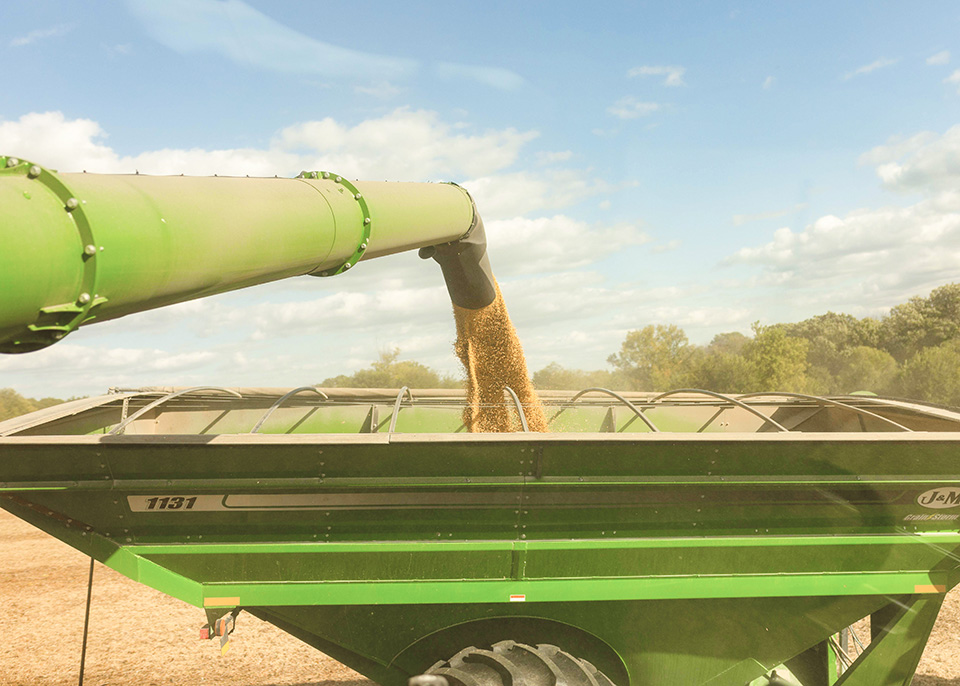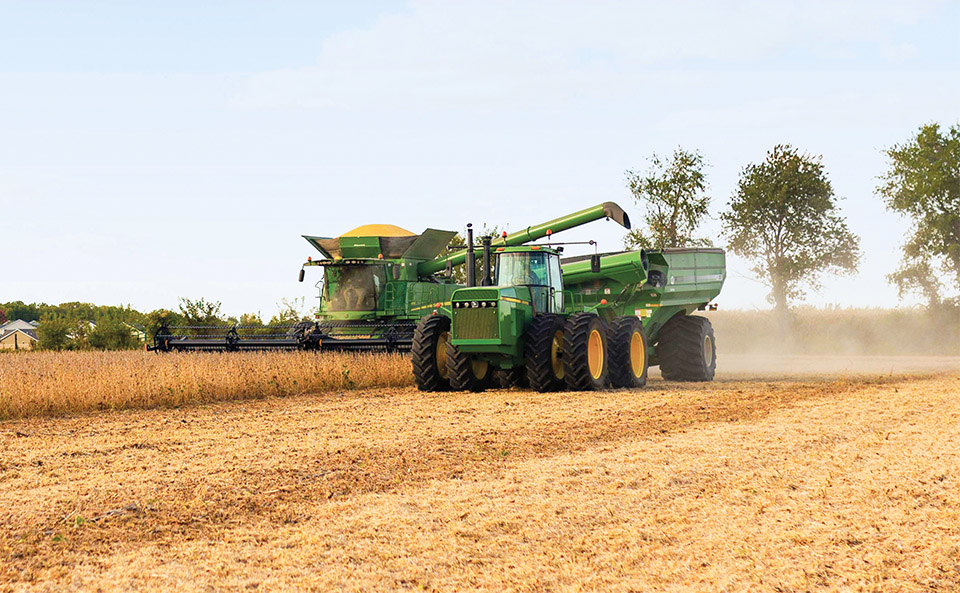
(Photo: Iowa Soybean Association / Joclyn Bushman)
How should you use farm data?
December 1, 2023 | Bethany Baratta
Sit in the driver’s seat during planting or harvest, and soon you’ll be inundated with data. You’ll not only see your speed across the field, but real-time planting or harvest conditions.
“There’s a sensor for everything,” says Robb Ewoldt, a farmer near Davenport and a past Iowa Soybean Association (ISA) president.
But what do farmers do with all that data?
Probably not as much as they could, farmers say, because of the sheer amount of data to sift through.
“We capture electronic data on our sprayer, our planters and our combine. We also capture it on our air seeder when we plant cover crops,” Ewoldt says.
The International Data Corporation (IDC) estimates that the average farmer generates 500,000 data points every day.
Real-time data like seeding rates, planting depth, grain moisture and yield are the most used instantaneously, Ewoldt says, but there is some information stored for potential use later. On the sprayer, for example, Ewoldt uses the time and date stamp to prove he’s applying at the correct rate and in the correct conditions. The data is stored electronically and can be pulled should he ever be audited.
With harvest data, he can determine how products such as fungicides, fertilizers and microbials performed during trials.
“It’s easy for me to capture data when we’re putting the product on, and then overlay the yield data at the end,” Ewoldt says.

Crop insurance reporting
Precision data from the planter and combine can also be used to streamline crop insurance, says Pat Swanson, ISA board director and co-owner of Son Risk Management, a crop insurance agency in Ottumwa.
“We encourage our farmers to use precision planting and harvest data,” Swanson says. “By using precision technology, the data can be used to report acres planted and production harvested.”
As long as the combine has been calibrated and the correct procedures have been followed, Risk Management Agency (RMA), which oversees the federal crop insurance program, recognizes the precision data for a claim situation without having to gather manual measurements or records, saving the farmer time, Swanson says.
Crop insurance was the catalyst that encouraged Ewoldt to embrace precision data on his farm. He delighted in the fact that using precision data meant no longer having to keep three years’ worth of weigh slips or settlement sheets.
“It’s an ease of mind for me,” Ewoldt says. “If I ever get audited for a claim, I can refer them to my agent, who has all of the data stored electronically."
Quality in, quality out
The data coming out of the many platforms available to farmers is only as good as the information inputted into the system, Ewoldt says.
“The more time you spend in calibrating, I think, the truer reading you get of every acre,” he says.
Swanson and her husband, Don, began working with Advanced Agrilytics Agronomy Sales Lead Brian Strasser this year to fine-tune the mapping of their acres.
They drove around all the fields, documenting the perimeters, waterways and grass strips.
“We don’t want to plant seeds or spray chemicals in our waterways or on our grass buffer strips. We are concerned about water quality and keeping our soil on our farm,” says Pat, who was recognized recently as a Front Forty Champion for her work in championing innovative conservation technologies.
“The time spent mapping will save us money on seed and chemicals and helps us justify our precision equipment investment,” Swanson says.

Having precision data is key to management, says Strasser, who works with farmers in southwest Iowa and northeast Missouri.
He works directly with farmers in various stages of data collection. Some, like the Swansons, have been using precision data for several years and want to fine-tune their mapping. Others aren’t as advanced.
“When we go to the grower and they don’t have the data, we have to start on the journey of capturing the data so we can be more successful for them in the future,” says Strasser, a farmer and ISA member.
Strasser works with customers to make recommendations about how they can improve water movement and nutrient absorption in their fields. Then, he helps connect them to the experts.
“We’re trying to arm farmers for all weather environments,” Strasser says. “We’re talking about using the resources we already have available — water and nutrients, for example — in a very targeted, smart and educated way.”
Improving business
While the harvest map is essentially the report card of the growing season, the data surrounding the growing season helps farmers make decisions. Planter data provides insights on planting conditions and varieties. And, because Ewoldt also uses the planter to apply fertilizer, the data also informs about various rates of fertilizer applications. Data from the strip-till bars also help make future field management decisions.
But what does the future of data collection and usage look like? IDC estimates the amount of data collected daily will increase 800% by 2036, driven by the increase of sensors and other technologies.
That’s where Ewoldt thinks Artificial intelligence, or AI, will play a role.
“There’s probably something we’re capturing that we haven’t been able to find a correlation to something else,” says Ewoldt, who hires someone to synthesize the data points his numerous systems capture. “When you look at the amount of data captured, there’s no way any human can look over it and utilize it all at this point. Maybe AI will go to the next level; knowing soil temperature, moisture levels and all the other data points, it will suggest how we can tweak our management and provide the recipe for a perfect crop.”
Your turn
How do you manage your data? What's your most important data point? Email me at bbaratta@iasoybeans.com or call me at 515-334-1020.
Back